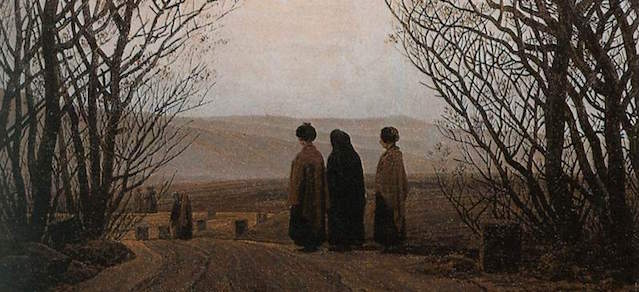
05 May Reflections on the Resurrection Appearances of Christ
The Resurrection appearances of Christ unfold in light of His Ascension, which will bring them to a close. The appearances are about self-manifestation, about Christ showing Himself risen in the flesh; but all the time they are tending towards being overcome, giving way to a bodily absence, sealed by the Ascension, which is at the same time an entirely new and more intimate way of being present.
We can see this in a number of ways. First, following the Resurrection Christ isn’t always bodily present to the world, but rather He mysteriously makes Himself present and just as mysteriously disappears. The times of His disappearance, His absence, anticipate and prepare for the definitive withdrawal which the Ascension will soon accomplish.
Moreover, secondly, even in bodily presence, Christ acts enigmatically, in ways which ineffably combine presence and absence. He appears among us in the flesh, as a man, but we do not know that this flesh is His, that this man is Christ Himself. He gives Himself to us, speaks with us, eats with us, interacts with us in familiar ways, but He does so as a stranger, as an unknown visitor or companion: and in each case, as the Gospel expresses it, despite being with us in the flesh, even so our eyes are kept from recognizing Him. This hiddenness which He practices transforms even the times of His presence, once more pointing to the Ascension by which His presence in the flesh will eventually be definitively withdrawn.
Now this interplay of presence and absence, between Resurrection and Ascension, isn’t just a kind of Divine conjuring trick. It has a profoundly important significance. It teaches us that Christ does not mean to make Himself available to us in the ordinary way, as a particular man whom we can identify and hold on to. What we are being shown is that we must surrender that way of relating to Him. Instead we have to venture into a different conception of His presence among us. This conception points to a kind of presence that is more mysterious, more challenging, and yet at the same time more inward and encompassing than His presence in the flesh could ever be.
In the Gospel the heart of that new presence is revealed as Eucharistic. When He was at table with them, He took the bread and blessed, and broke it, and gave it to them. And their eyes were opened and they recognized Him; and He vanished out of their sight.
What does this extraordinary sequence of events tell us? It tells us that it is in the bread, broken and given, that the One Who brings us together is recognized as Christ Himself. And it tells us that the security of that moment of recognition isn’t rooted in face to face contact with Him, since it is simultaneous with His vanishing from our sight.
What does this vanishing of His presence in the flesh leave us with? We are left with the bread with which He has gifted us, and we are left with each other, newly constituted as recipients of this bread.
These things coexist with the impossibility of recognizing Him in the flesh, for He is no longer before us to be recognized in that way. But we are enabled to recognize Him nonetheless, according to a new understanding of Him and of ourselves, which commences precisely here, in the Eucharist, where the flesh of Christ reconfigures and communicates itself in bread broken and given. What we now see is that these realities, remaining in the wake of His vanishing – the bread He gives us, the communion with Him and with each other which it fashions – what we now see is that these things are manifestations of Christ Himself, of His risen flesh, new modes of His presence and His life in the world. Recognition of Him in the flesh has been superseded. Or rather, it has not so much been superseded as redirected, relocated – away from the risen body, no longer accessible to us, and concentrated instead upon the bread, broken and distributed among us. He is known to us now, as the Gospel tells us, in the breaking of the bread.
This new way of being present to us has two, profoundly interrelated, dimensions.
First, even as His risen flesh vanishes, in one way, it reappears, in another: it reappears according to its transformation into bread and the communion which it brings about. Henceforward this is how He is present to the world, this is how He shows Himself there.
But also, secondly, this transformation of His flesh is, at the same time, a transformation of the bread and of the communion which receive His flesh and make it available. The bread He gives us is no longer ordinary bread but Himself, and the communion it fosters is no longer ordinary fellowship but a new way of belonging to Him which is at the same time a new way of belonging to each other. Just as Christ newly manifests Himself in bread and in human community, so bread and human community newly manifest themselves as bearing the presence and life of the risen Christ. The Risen Christ Eucharistically empties Himself into the world, into human nourishment and belonging; and because He does so the world, our nourishment and our belonging, gets taken up Eucharistically into the risen Christ.
From now on this is how He is with us, and how we are with Him. He and we are no longer face to face – and, as the Gospels show us, even if we were we would likely find ourselves incapable of recognizing Him. Instead He comes to us Eucharistically as nourishment, as community, and as life itself. And we in turn are taught to seek Him Eucharistically, and to carry from the Eucharist into the world all that He gives us here, in this way coming to participate in His work of redemption and sanctification. In receiving Him as bread, broken and handed over, we in turn become what we receive. We become extensions of His self-giving on behalf of the world, so as to reconcile and restore it to the Father.
By Fr Philip Cleevely, Cong. Orat.

